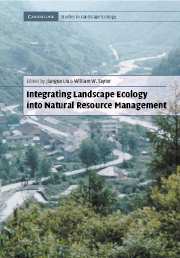Book contents
- Frontmatter
- Contents
- List of contributors
- Foreword
- Preface
- Acknowledgments
- PART I Introduction and concepts
- PART II Landscape structure and multi-scale management
- PART III Landscape function and cross-boundary management
- PART IV Landscape change and adaptive management
- PART V Landscape integrity and integrated management
- PART VI Syntheses and perspectives
- Index
- Plate Section
Preface
Published online by Cambridge University Press: 14 January 2010
- Frontmatter
- Contents
- List of contributors
- Foreword
- Preface
- Acknowledgments
- PART I Introduction and concepts
- PART II Landscape structure and multi-scale management
- PART III Landscape function and cross-boundary management
- PART IV Landscape change and adaptive management
- PART V Landscape integrity and integrated management
- PART VI Syntheses and perspectives
- Index
- Plate Section
Summary
Traditionally, natural resources have been often managed using information collected from small scales, resulting in variable and limited success. To improve these results, many scientists and natural resource managers have recognized the need to adopt a large-scale approach to natural resource management, using the concepts, principles, and methods of landscape ecology. At the same time, many landscape ecologists have also realized that further development of landscape ecology will benefit from better connections with resource management issues. However, as is often the case between academic and non-academic worlds, landscape ecologists and natural resource managers historically have not communicated well. Landscape ecologists often do research without regard to the needs for natural resource management, and managers often do not know how to apply landscape ecology to managing natural resources.
To facilitate the communication between landscape ecologists and natural resource managers, we hosted the 13th annual conference of the US Regional Association of the International Association for Landscape Ecology (US-IALE) on the campus of Michigan State University in 1998. The conference's theme was “Applications of landscape ecology in natural resource management.” Clearly, this theme of linking landscape ecology with natural resource management reflected the desire of many others, as more than 500 landscape ecologists and natural resource managers from around the world participated in the conference (the largest number ever to attend a US-IALE annual meeting).The conference was a huge success, but we were urged by many attendees to produce a book expanding upon the ideas presented at the conference, reaching a larger audience, and promoting further communication and collaboration between the landscape ecology and natural resource management communities.
- Type
- Chapter
- Information
- Integrating Landscape Ecology into Natural Resource Management , pp. xvi - xviiPublisher: Cambridge University PressPrint publication year: 2002



